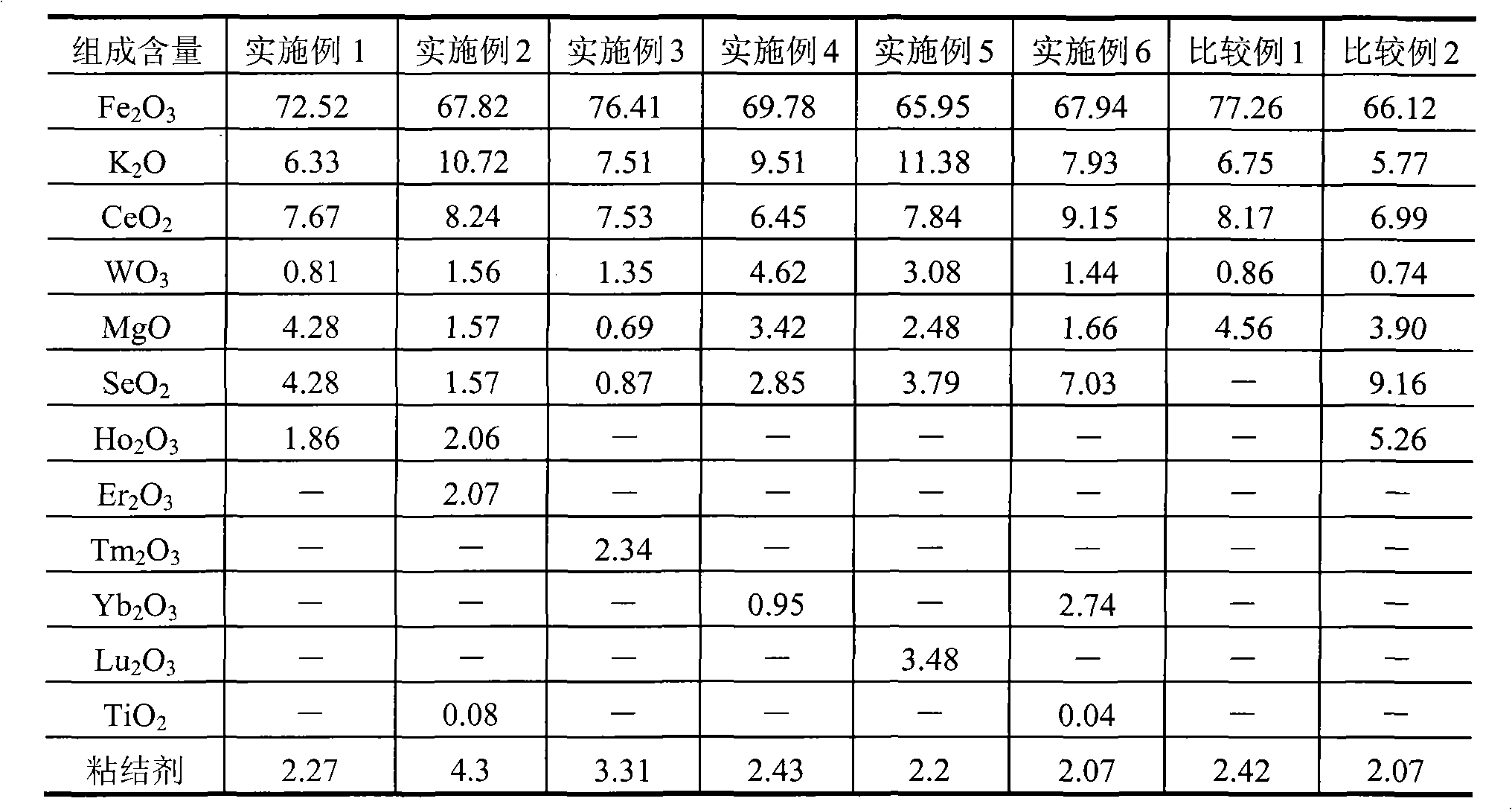Low-temperature ethylbenzene dehydrogenation catalyst
A technology of ethylbenzene dehydrogenation and catalyst, applied in physical/chemical process catalysts, metal/metal oxide/metal hydroxide catalysts, hydrocarbons, etc., can solve the problems of low potassium catalyst activity and achieve improved electronic performance Transmission channels, improve activity, improve the effect of alkalinity
- Summary
- Abstract
- Description
- Claims
- Application Information
AI Technical Summary
Problems solved by technology
Method used
Image
Examples
Embodiment 1
[0028] 320.0 grams of iron oxide red, 100.0 grams of iron oxide yellow, 50.0 grams of potassium carbonate, 85.0 grams of cerium oxalate, 5.0 grams of ammonium tungstate, 23.0 grams of magnesium oxide, 23.0 grams of selenium oxide, 10.0 grams of holmium oxide, 12.2 grams of cement and 22.0 grams Stir the sodium carboxymethyl cellulose in a kneader for 1 hour, add deionized water, and stir for another half an hour, take out the extruded strips, extrude them into granules with a diameter of 3 mm and a length of 5 to 8 mm, put them in an oven, and bake at 110 ° C for 2 hour, then placed in a muffle furnace, roasted at 300°C for 2 hours, and roasted at 900°C for 4 hours to obtain a finished catalyst. The weight percent composition of the catalyst is listed in Table 1.
[0029] 100 milliliters of catalysts are loaded into the reactor, at normal pressure, liquid space velocity 1.0 hours -1 , 610°C and 580°C, and water ratio (weight) 2.0, the activity evaluation was carried out, and t...
Embodiment 2
[0031] Prepare catalyst by the method for embodiment 1, difference is with 200.0 gram iron oxide red, 180.0 gram iron oxide yellow, 85.0 gram potassium carbonate, 116.3 gram cerium nitrate, 8.3 gram tungsten oxide, 8.0 gram magnesium oxide, 8.0 gram selenium oxide , 0.4 gram of titanium oxide, 10.6 gram of erbium oxide, 10.4 gram of holmium oxide, 22.2 gram of kaolin and 32.5 gram of graphite, the weight percent composition of gained catalyst is listed in Table 1.
[0032] Activity evaluation was carried out according to the evaluation conditions of Example 1, and the test results are listed in Table 2.
Embodiment 3
[0034] Prepare the catalyst according to the method of Example 1, except that 310.0 grams of iron oxide red, 160.0 grams of iron oxide yellow, 63.6 grams of potassium carbonate, 59.5 grams of cerium carbonate, 9.0 grams of ammonium tungstate, 4.0 grams of magnesium oxide, 5.0 grams of oxide Selenium, 13.5 grams of thulium oxide, 19.2 grams of diatomaceous earth and 17.2 grams of polystyrene microspheres, the weight percentage composition of the catalyst is listed in Table 1.
[0035] Activity evaluation was carried out according to the evaluation conditions of Example 1, and the test results are listed in Table 2.
PUM
 Login to View More
Login to View More Abstract
Description
Claims
Application Information
 Login to View More
Login to View More - R&D
- Intellectual Property
- Life Sciences
- Materials
- Tech Scout
- Unparalleled Data Quality
- Higher Quality Content
- 60% Fewer Hallucinations
Browse by: Latest US Patents, China's latest patents, Technical Efficacy Thesaurus, Application Domain, Technology Topic, Popular Technical Reports.
© 2025 PatSnap. All rights reserved.Legal|Privacy policy|Modern Slavery Act Transparency Statement|Sitemap|About US| Contact US: help@patsnap.com



